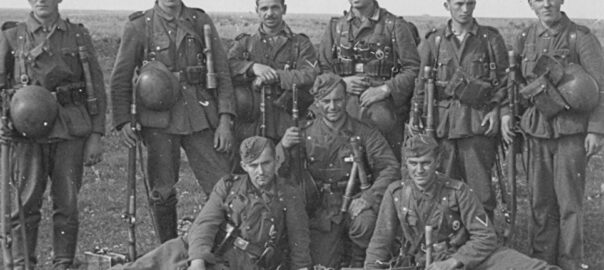The German tunic (Feldbluse) of the Second World War was a well-engineered garment, designed look sharp, be comfortable and functional. However, it was overly complex, requiring an inordinate amount of labor time to manufacture which certainly caused manufacturing difficulties both in WWII and for today’s reproductions.
Despite claims by many manufacturers of reproduction uniforms, very few, if any, have actually managed to duplicate the pattern and sizing system. Aside from the complexity of the garment itself, there are three main reasons for these failings- lack of original examples, a minimal understanding of the sizing system, and the tendency to associate the tunic with a suit coat.
Original Heer uniforms are not particularly difficult to find- but they are relatively expensive, with examples in good condition costing about $1,500-$5,000 at the time of this writing. To accumulate a wide range of sizes and styles can cost tens of thousands of dollars. Further complicating this is the fact that many tunics were altered during the War, which often ruins any patterning value they may have had.
The “secrets” of German uniform sizing are stamped right in the tunics themselves. Unlike the US Army, which simply used the chest size and length, the ever-anal-retentive Germans include the chest, neck, sleeve, waist and back dimensions in the size stamps. Later tunics also give the height range of the soldier the tunic is intended to fit.
The biggest mistake made by most reproductions is their application of suit coat patterning standards to the German tunic. These have been around for years and it’s an understandable error. The grading rules (how the parts of the garment “grow” or “shrink” as the size changes) are readily available in books and online. Even the most expensive reproductions, those considered to be the best of the best, sometimes used these standards. All one needs is a tape measure to figure that out.
What’s my documentation? My favorite social media reenacting celebrity who has a vast collection of reproductions says otherwise!
Well, we’ve been making German uniforms for nearly 30 years, we have several dozen originals on hand to check, plus WWII tailoring standards and tunic specifications, the hdv 337 German Army sizing guide, and we’ve dis-assembled numerous originals to verify our patterns. That’s about all.
How did the Germans size their Tunics?
The Wehrmacht’s sizing system was typically German; entirely systematic and logical, yet in practice it could be a supply sergeant’s nightmare. The WWII German tunic sizing allowed a very exacting fit to be ordered for each soldier. Like most uniforms, tunics were sized by chest measurement and length, the latter being indicated by the torso length (Rückenlänge).
If all chest (32-50) and length combinations are considered, there are over 128 possible sizes (as compared with about 50 sizes for US Service Coats.) Each chest size also could be ordered with 3 different neck sizes and each torso length had 3 possible sleeve lengths…once those are figured in, 128 becomes over 1100 possible unique size combinations. Typical German.
What size is it? If one is shopping for an original tunic, learning the numbers will enable you to determine the size of a uniform simply by seeing the size stamp. Once one knows them well, it also helps spot fakes due to outrageous “sizes” sometimes stamped in them. Helping to identify legitimate SS tunics is also possible as they had slightly different proportions than Heer Feldblusen.
The Numbers: The numbers stamped inside the tunics tells most of the story. Here we break them down to help you understand what they mean. Most tunics have a block of with 5 measurements stamped inside the placket. A few have additional sizes and measurements- this will be addressed below.
Size = the size of the chest or neck as measured on the soldier. The actual measurement of the garment will be larger to enable freedom of movement.
Measure = actual measurement in centimeters of the uniform part
This is the most common format of the number blocks indicating the size of the tunic
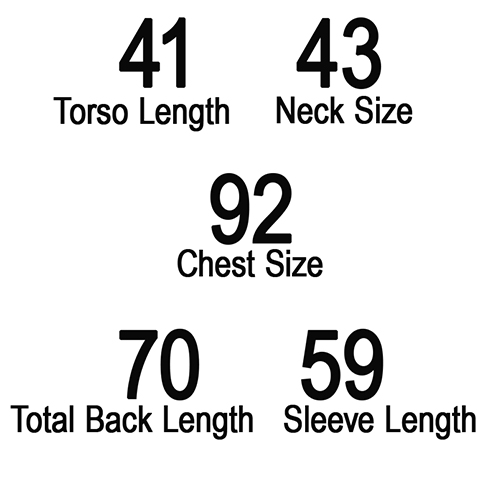
Chest sizes: Tunics are first sized by the soldier’s chest. The number stamped in the tunic represents the size chest it will fit, not the actual measurement of the tunic. The garment typically measures 8-10cm larger than marked to allow for undergarments and freedom of movement. Thus, a “size 100″ will measure about 110cm. Original uniforms were made in essentially .75” (2cm increments) starting at 82cm.
Length: Next, the length must be determined. Instead of “shorts”, “regulars”, etc, the Germans indicated the length by the Rückenlänge translated as “torso length”.
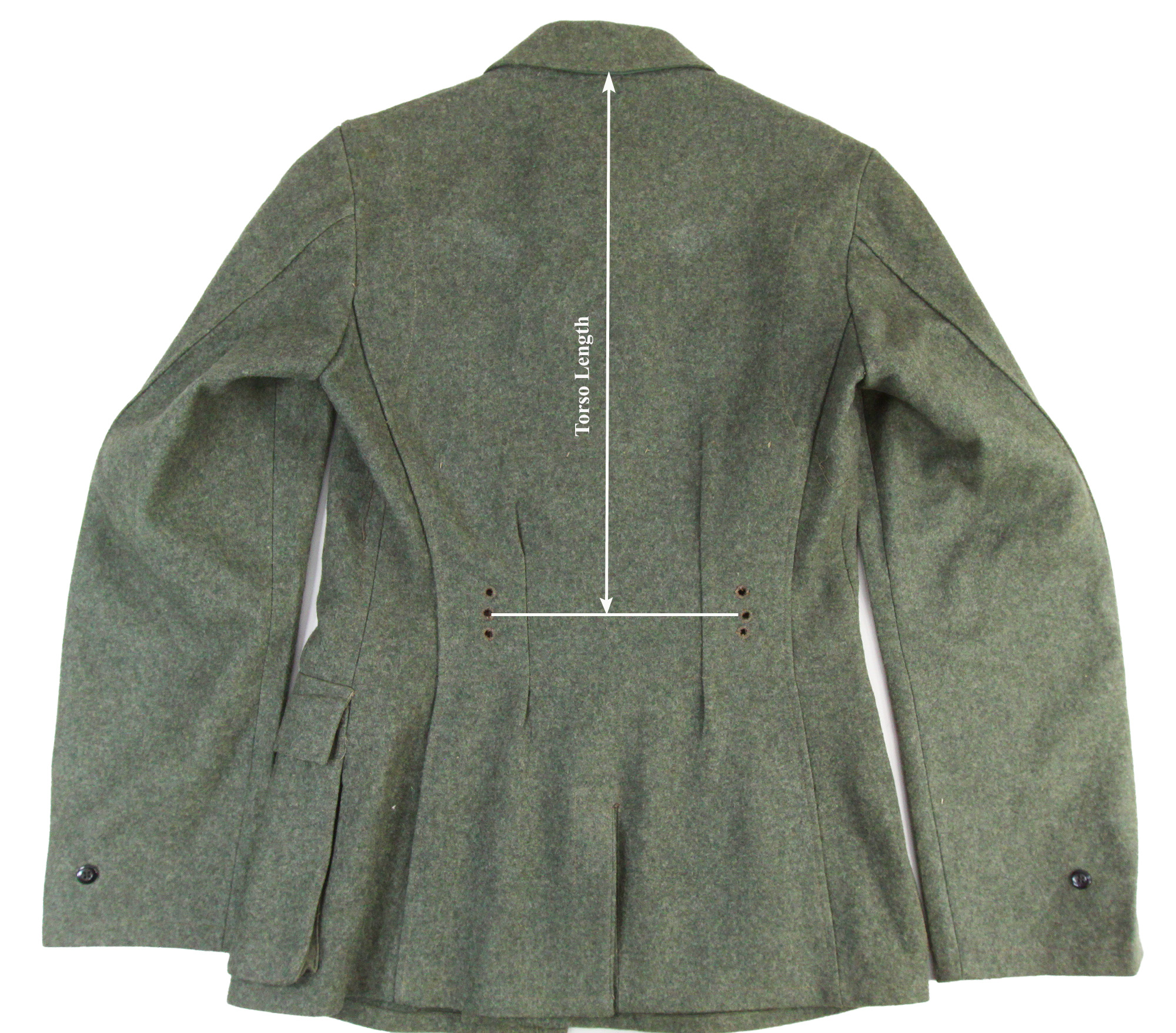
Torso Length: The length of a German tunic is determined by the upper left-hand number on the size stamp. This is the Rückenlänge or torso length, sometimes translated as “back waist” or “belt line”. It’s measured from the base of the collar to the level of the center belt hook hole. In theory, this places the belt at the wearer’s natural waist, the narrowest part of the torso. It is not based on the height of the soldier’s elbow, his shoe size, or any other nonsense.
German tunics came in no less than 8 back waist lengths, each of which is designed to fit a soldier of a certain height. Heer uniforms use back waist lengths of 37, 39, 41, 43, 45, 47, and 49. Those cover soldiers from 145cm (under 5ft.) to 200cm (6ft. 6in) in height.
SS and Luftwaffe tunics use even or odd numbers 38-49 so they have at least 12 possible lengths. The reason for this difference is unknown. Hdv 337 notes that Heer Feldblusen only come in odd number lengths as the belt hooks offer 1cm of adjustment longer or shorter. Thus, a tunic with a length of 45, can be adjusted to 44 or 46 by using the upper or lower belt hook holes. (Paragraph 3, page 39. See below.)
This length system remains constant throughout all chest sizes.
Documentation
For those who demand documentation…here it is. Heeres Druckvorschriften 337: “Regulations for the sizing of the most important uniform items”.
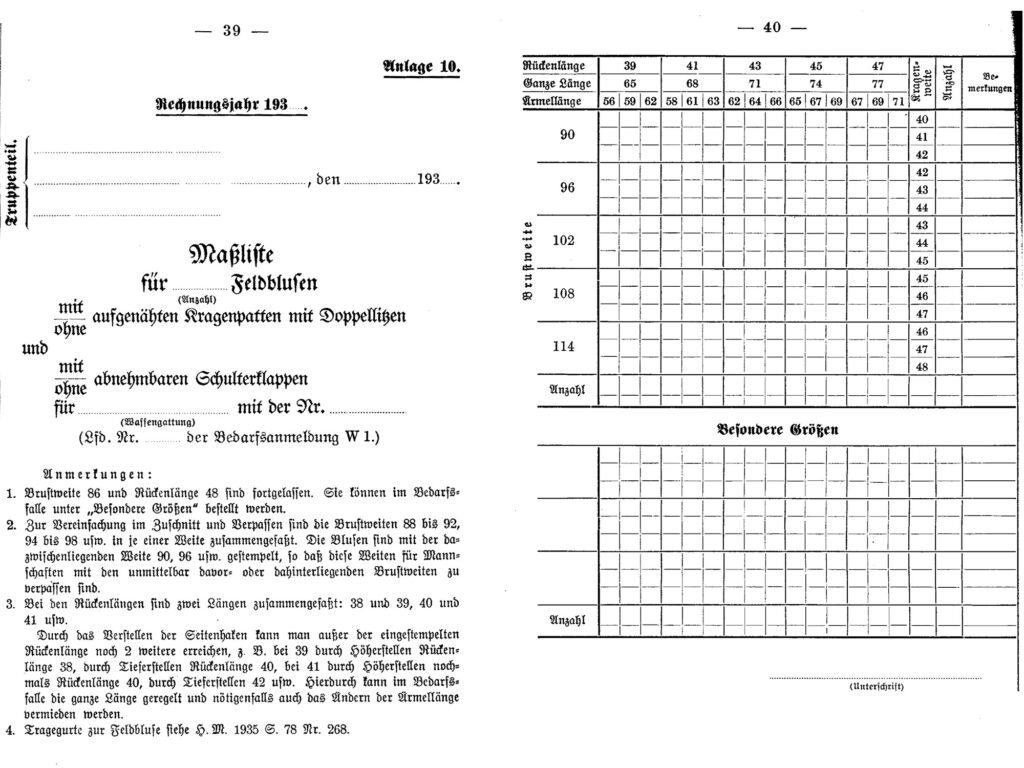
Total Back: (Ganze Länge) The distance from the base of the collar to the hem of the skirt. This was dispensed with on some late War number blocks. By taking the difference of the Back length and total back, one can arrive at the skirt length. This can matter when checking for SS tunics, which usually have shorter skirts than comparable length Heer tunics.
Sleeve Lengths: There is more variation here than with the torso lengths. Although it would seem reasonable to have a stock sleeve length for each Rückenlänge, I have found this not to be the case. Each length of tunic (for example, “43”) can have a range of sleeves lengths, typically varying by 3-4 cm. Say 62, 63 or 64 on a Rückenlängen of 43. So, some tunics will have cuffs that end below the skirt, and other will be higher. Why or how this was determined is unknown.
Neck Size: The circumference of the collar is associated with the chest size. Each chest size will normally have one of two possible collar sizes. A 96 typically has a 42 or 43, a 104 has a 44 or 45 and so forth. Again, anomalies exist, but there is a distinct average.
Size Block Variations
One will encounter a number of variations when looking at authentic Feldblusen. Below are two of the more common ones. On some later War examples with the height range, the total back and sleeve lengths are dropped, some Panzer jackets dispense with the total back length, and occasionally DAK tunics lack a neck size.
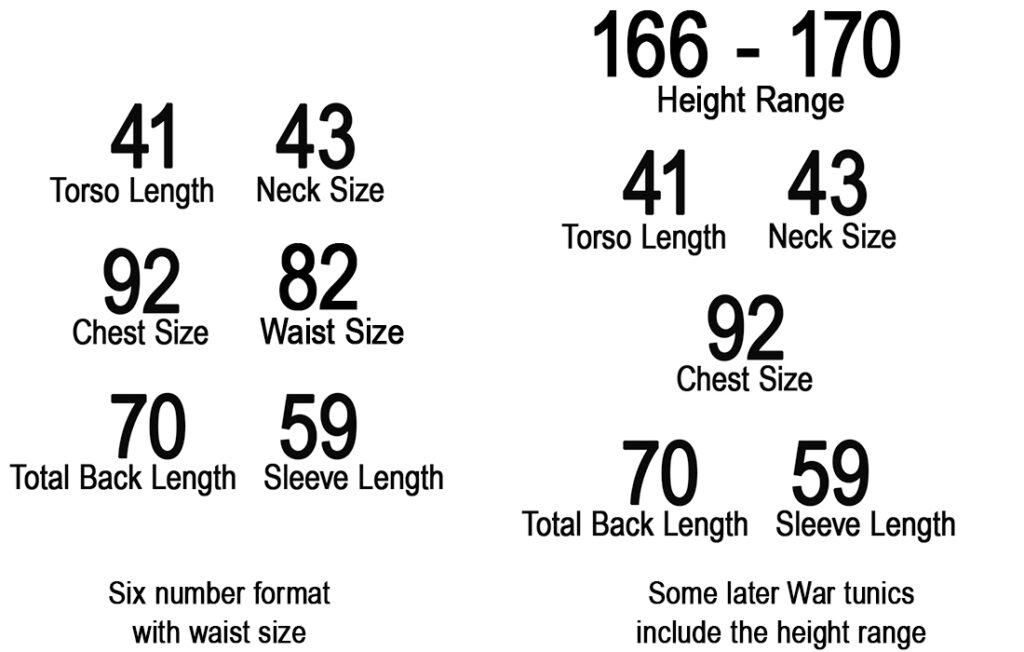
Errors: Lastly, yes, the size stamps are sometimes found to be incorrect. At times the chest is off by a few cm’s, while others the size is wildly incorrect. Many large size Feldblusen can be found today that were tailored to a smaller size, but those often have the original numbers struck out and the new ones stamped below them. If the uniform is unissued and has the paper tag from the factory still attached, the tag is typically correct if it does not match the stamp inside. This is especially the case when the tags are hand written.
